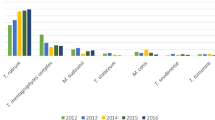Abstract
Sixty patients clinically suspected of tinea cruris were studied by collecting skin scrapings from the site of their lesions and six clinically normal sites including the thighs, scrotum, crural clefts, natal cleft and the web between their 4th and 5th toes. Dermatophytes were detected in scrapings in 46 (77%) and by culture in 36 (60%) patients from lesions. Trichophyton rubrum was isolated from 32 and Epidermophyton floccosum from 4 patients. Dermatophytes were also isolated with maximum isolation from the scrotum, crural clefts and the natal cleft in that order. Thus, when tinea cruris is treated with topical antifungal agents they should be applied also to the potential carriage sites to prevent recurrence.
Similar content being viewed by others
References
Shah HS, Amin AG, Kanvinde SM, Patel GD. An analysis of 2000 cases of dermatophytosis. Indian J Pathol Bacteriol 1975; 18: 32–7.
Talwar P, Hunjan BS, Kaur S, Kumar B, Chitkara NL. Study of human dermatophytosis. Indian J Med Res 1979; 70: 187–94.
Sharma SC, Talwar P, Kumar B, Sharma M, Kaur S, Bedi TR. Tinea cruris in Chandigarh. Indian J Dermatol Venerol Leprol 1980; 46: 216–7.
Emmons CW, Binford CH, Utz JP, Knowchung KJ. Medical Mycology. Philadelphia: Lea and Febiger, 1977; 117–67.
Rippon JW. Medical Mycology: The Pathogenic Fungi and the Pathogenic Actinomycetes. Philadelphia: WB Saunders, 3rd Ed, 1988; 169–275.
Svejgaard E, Christiansen AH, Stahl D, Thomsen K. Clinical and immunological studies in chronic dermatophytosis by Trichophyton rubrum. Acta Dermatovenereologica (Stockholm) 1984; 64: 493–500.
Svejgaard E, Jakobsen B, Svejgaard A. HLA studies in chronic dermatophytosis caused by Trichophyton rubrum. Acta Dermatovenereologica (Stockholm) 1983; 63: 254–5.
Grappel SF, Bishop CT, Blank F. Immunology of dermatophytes and dermatophytosis. Bacteriol Reviews 1974; 38: 22–250.
Hashimoto T, Emyanitoff RG, Mock RG, Pollack JH. Morphogenesis of the arthroconidium in the dermatophyte Trichophyton mentagrophytes with special reference to ontogeny. Canadian J Microbiol 1984; 30: 1415–21.
La Touche CJ. Scrotal dermatophytosis. Br J Dermatol 1967; 79: 339–44.
Davis CM, Garcia R, Riordon JP, Catlin G. Dermatophytes in military recruits. Archives Dermatol 1972; 105: 558–70.
Khudsen EA. The real extent of dermatophyte infections. Br J Dermatol 1975; 92: 413–6.
Author information
Authors and Affiliations
Rights and permissions
About this article
Cite this article
Chakrabarti, A., Sharma, S.C. & Talwar, P. Isolation of dermatophytes from clinically normal sites in patients with tinea cruris. Mycopathologia 120, 139–141 (1992). https://doi.org/10.1007/BF00436390
Received:
Accepted:
Issue Date:
DOI: https://doi.org/10.1007/BF00436390



